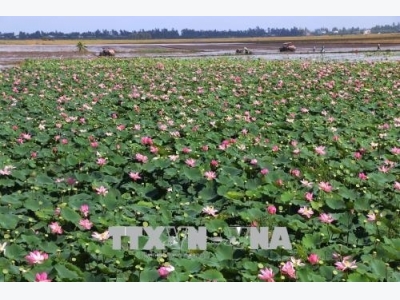Mekong Delta to grow other crops on 118,290ha of rice paddies

Nguyễn Văn Hiếu’s lotus field in Đồng Tháp Province’s Thanh Bình District. In many places in the Mekong Delta, farmers are switching from rice to other crops to earn higher incomes. - VNA/VNS Photo Nguyễn Văn Trí
Ho Chi Minh City – Some 118,290ha of rice fields affected by lack of water and saltwater intrusion in the Cửu Long (Mekong) Delta will be used to grow other crops or aquaculture this year, according to the Plant Cultivation Department.
During the 2017-18 winter-spring rice crop season corn, peanut, soybean, vegetables, orange, grapefruit, mango and other fruits were grown on more than 16,000ha of paddies.
Since winter-spring is the main rice season the area converted was not large, but it will increase as the year progresses, according to the department.
The switch has provided higher incomes to farmers in recent years.
Năm Roi grapefruit yields an income of around VNĐ660 million (US$29,000) per hectare per year while for king orange it is VNĐ370 million ($16,300), many times higher than from rice, according to the department.
In Trà Vinh Province, local authourties plan to convert more than 7,500ha of rice fields this year.
Of this, 5,833ha will be used to grow cash crops like corn, sweet potato and vegetables, 829ha to grow fruits and 853ha for the rice-aquaculture farming model.
Last year only 2,500ha were converted.
In Đồng Tháp Province, farmers have used rice fields to try several other farming models in recent years, including the rice-lotus rotating model.
Đồng Tháp, the Delta’s largest lotus cultivating area, turned 100ha of rice fields into lotus fields in the 2017-18 winter-spring crop.
Farmers earned an average profit of VNĐ100 million ($4,400) per hectare from lotus, according to the province Department of Agriculture and Rural Development.
Nguyễn Văn Hiếu, who rotates lotus and rice on a two-hectare field in Thanh Bình District’s Tân Mỹ Commune, said he hoped to earn VNĐ200 million ($8,800) from growing lotus this winter-spring season.
In summer-autumn he will grow rice.
Many farmers in Tháp Mười District, Đồng Tháp’s largest lotus cultivation area, also use their lotus fields as tourist attractions to earn an extra income.
Lê Văn Ngọt, who grows lotus on four hectares in Tháp Mười District, said tourism brought him two or three times the income he got from growing lotus.
The district will first stabilise the area under lotus at 300ha before expanding in future since the flower fetches a higher income than rice, according to the local People’s Committee.
Có thể bạn quan tâm
Phần mềm

Phối trộn thức ăn chăn nuôi

Pha dung dịch thủy canh

Định mức cho tôm ăn

Phối trộn phân bón NPK

Xác định tỷ lệ tôm sống

Chuyển đổi đơn vị phân bón

Xác định công suất sục khí

Chuyển đổi đơn vị tôm

Tính diện tích nhà kính

Tính thể tích ao hồ



 Ample opportunities in Vietnamese horticulture industry
Ample opportunities in Vietnamese horticulture industry  Bến Tre pomelo, coconut GI certified
Bến Tre pomelo, coconut GI certified